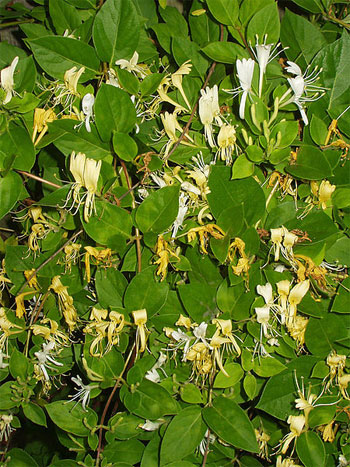Each spring, the honeysuckle flowers gather at the end of their stems to trumpet their sweet, gentle scent of purification and renewal. When I lead an herb walk in my backyard, I always pause with my students in homage at the woodbine (honeysuckle vine) and discuss the powerful antibiotic, antiviral, anti-inflammatory and not least, anticancer properties of this gentle herb.
Honeysuckle flowers tend to grow in small clumps of up to eight or more blossoms. At first, they are luminescent white; then, as the heat of the sun bears down on them, they begin to yellow with age. I don’t know it for certain, but I imagine that the white flowers are more potent. I single these out for harvest.
Medicinal Applications of Honeysuckle Flowers and Leaves
Jin yin hua, the most common species of honeysuckle used in Asia, is Japanese honeysuckle (Lonicera japonica). With over a hundred species worldwide, ranging in a wide arrange of sizes and colors (including red!) the plants are all in the Caprifoliacea family along with Sambucus (elder). According to herbalist Christopher Hobbs, elder has chemistry and properties similar enough to be used interchangeably with honeysuckle flowers. Lonicera fruit can be red, blue or black and contain several hard seeds. In most species the berries are regarded as mildly poisonous with the notable exception of L. caerulea whose berries are edible. Nevertheless, it is not the berries, but the flowers and leaves that we are after when we look to honeysuckle as a medicinal.
Jin yin hua, which aptly translates as ‘golden silver flower,’ is one of the first herbs considered for the treatment of infections, inflammation, fevers and toxicity. It is an herbal antibiotic effective against a broad spectrum of bacteria including Staphylococcus, Streptococcus, Bacillus dysenteeriae, Vibrio cholera, Salmonella typhi, Diplococcus pneumonia, Diplococcus meningitides, Pseudomonas aeruginosa and Mycobacterium tuberculosis. Chlorogenic acid and isochlorogenic acid in the herb has the strongest antibiotic effects. According to Chen and Chen (Chinese Medical Herbology and Pharmacology, 2004, Art of Medicine Press Inc.), the fresh herb only soaked in water has a stronger antibiotic than an herbal decoction, with the leaves having an even stronger antibiotic properties than the flowers.
Honeysuckle flowers are classified as sweet and cold and enter the Lung, Stomach and Large Intestine meridians. They are effectively dosed anywhere from 10 to 60 grams and are used for the common cold with symptoms of fever and thirst, upper respiratory tract infections, boils, furuncles, enteritis and dysentery. For diarrhea and dysentery with watery stool, honeysuckle is taken dry fried and carbonized.
One of the most common formulas using honeysuckle is the famous Yin Qiao San, widely used for treating colds and influenza. However, its broader detoxifying and heat-clearing properties makes it useful for inflammatory skin conditions, inflammations of the upper respiratory tract and is taken both internally and externally for mastitis as well as lung and breast cancer. Several studies have shown that extracts of honeysuckle promote apoptosis and inhibit tumor growth. For more on the anticancer uses of Lonicera and other herbs, I recommend my book Treating Cancer with Herbs published by Lotus press.
The flowers are not the only part of Lonicera that are useful medicinally. While not specifically designated, the leaves have even stronger antibiotic effects than the flowers. This may inspire herbalists to personally harvest and try using more generous doses of Lonicera aerial parts for all infectious diseases. In this regard, though I’ve not tried it, one might consider the use of strong honeysuckle tea, perhaps with added fresh ginger and a little licorice for recalcitrant infections like Lyme’s disease.
Traditional Chinese medicine (TCM) has a specific through similar anti-inflammatory use for Lonicera stems which are called jin yin teng or ren dong teng. This part of the plant has milder anti-toxin effects but is specific for arthritic and rheumatic conditions, described in TCM as bi pain or ‘wind-dampness.’
While many contemporary western herbalists regard honeysuckle as exclusive to the domain of Chinese herbal medicine, the Roman naturalist writer Pliny recommended it mixed with wine for the treatment of ‘disorders of the spleen.’ This may suggest yet another possible use for honeysuckle: depression. In ancient Greek humoural medicine, the spleen is associated with the black bile humour which in turn is associated with melancholy, or depression. To my knowledge there is no contemporary use of honeysuckle flowers for the treatment of depression unless one considers its use as a homeopathic Bach flower remedy for a certain kind of depression associated with nostalgia.
I’ve always been eager to incorporate and use any herb or healing principle so long as it is safe and effective. This is why I came up with my own approach to herbalism, Planetary Herbology embodied in the East West Herb Course. If I were an Ayurvedic herbalist or a curandero living in the Amazon jungle, if I learned about the fantastic uses of an herb like Lonicera, I’d have a hard time not wanting to put it to immediate use. If you’ve got a honeysuckle vine giving its profuse blooms over a fence or trellis in your yard at this time of year, I hope you’re inspired to snip some leaves and flowers for medicine; it’ll come in handy later this year!

